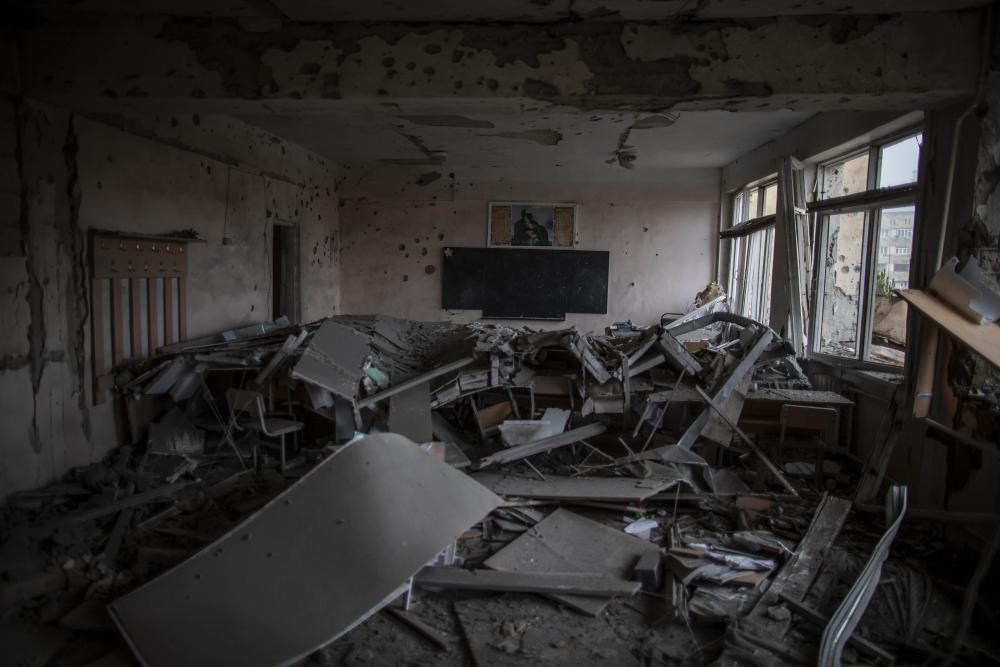The first children died on the first day of the war.
On September 27, 2020 a shell killed Victoria Gevorgyan. She was just 9 years of age. The shell landed in the yard of her home in the Martuni region of Nagorno-Karabakh. On the same day, in the Azerbaijani town of Naftalan, a shell killed Shahriyar Gurbanov, 13, and his cousin Fidan Gurbanova, 14, and three other members of the family while they were in the yard of their home.
During the next six weeks, more than 150 civilians were killed in fighting between Armenia and Azerbaijan over Nagorno-Karabakh according to reports. Victoria, Shahriyar and Fidan were not the only children among the dead: another 10 Azerbaijani children also perished. The conflict forced tens of thousands from their homes, at least temporarily.
During the fighting and afterwards, Human Rights Watch researchers visited sites that had been attacked in Azerbaijan and Armenian-controlled areas of Nagorno Karabakh to investigate whether the armed forces were following their obligations under the international laws of war to protect civilians from attack. We interviewed eyewitnesses, reviewed photographs and videos captured in real time by local residents on their mobile phones or published in the media, and examined satellite imagery to reach our conclusions. We met and corresponded with the respective authorities of Armenia and Azerbaijan and the de facto-authorities of Nagorno-Karabakh.[1]
This report looks at what happened to schools during the fighting between September 27 and November 9 and reveals some of the consequences of the conflict for school children.
According to official data, at least 71 schools on the Armenian side, including two in the Republic of Armenia, and 54 Azerbaijani schools were damaged or destroyed, as well as dozens of kindergartens, arts schools, sports schools, and vocational schools.
Schools on both sides had closed in March 2020 due to the Covid-19 pandemic. They had just reopened in mid-September but closed again when the fighting began. Many schools were repurposed as shelters for the displaced. In Nagorno-Karabakh, some schools were also used as military hospitals and barracks; some were looted by local residents and Armenian military forces.
Schools in both Armenia and Azerbaijan still memorialize the alleged war crimes committed by the other side in fighting that began in 1988 and escalated with the collapse of the Soviet Union in 1991. Armenia and Azerbaijan, which had both been republics of the Soviet Union, re-emerged as independent states amidst conflict over territory that forcibly displaced over one million civilians.
Nagorno-Karabakh, an ethnic-Armenian majority enclave in Azerbaijan, declared independence in 1991, but it has not been recognized by any United Nations member state or by multilateral organizations. By the time of the ceasefire in 1994, ethnic Armenian forces had taken control of seven Azerbaijani districts around the Nagorno-Karabakh enclave, creating a security buffer zone and a land connection to Armenia.
October 2
The Azerbaijani city of Tartar, on an ancient caravan route, was well within range of rockets and heavy artillery fired from the Armenian side during the fighting. Nearly every storefront on the main street was shattered when we visited. Satellite imagery from the time shows the town of Tartar was full of military transport trucks and ringed with military positions during the fighting.
Nonetheless, Armenian forces’ repeated use of imprecise, explosive weapons systems to attack densely-populated civilian areas inside the city was indiscriminate and therefore unlawful, we concluded at Human Rights Watch.
On October 2, a resident took a video of the dust and debris rising seconds after an artillery shell fired from the direction of the Armenian lines is heard slamming into a kindergarten in Shikharkh, a neighborhood built for people displaced by the war in the 1990s. Human Rights Watch verified the video, matching it with satellite imagery.
October 3
The next day, three artillery shells hit downtown Tartar’s School No. 1, pockmarking the red brick walls and flagstones of the courtyard, smashing window-frames and glass, damaging classrooms and shattering the windows of the kindergarten across the street.
As we examined the damage, the school guard told us there had been 1,300 students enrolled before schools closed due to the fighting.
Many civilians in Nagorno-Karabakh (referred to as Artsakh by Armenians) said there was nowhere in the enclave or surrounding districts where they felt safe from Azerbaijani shelling. Most women and children evacuated to Stepanakert (called Khankendi by Azerbaijan), the capital and largest city of the enclave, and then to Yerevan, Armenia’s capital, or other locations in Armenia.
When their village came under shelling from Azerbaijani forces, Narine Khachaturyan, 51, took her two daughters, one of whom was only 10, and fled for what she hoped would be the safety of her parents’ apartment in Stepanakert.
The continuation is in the article.

